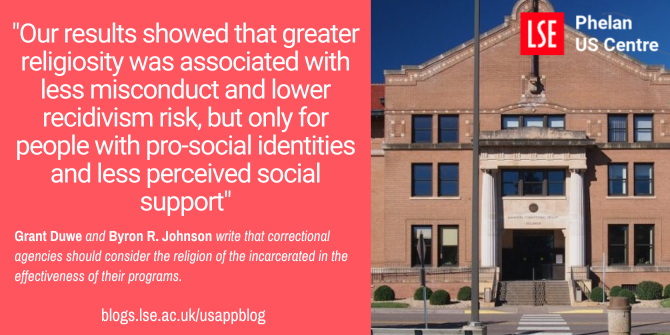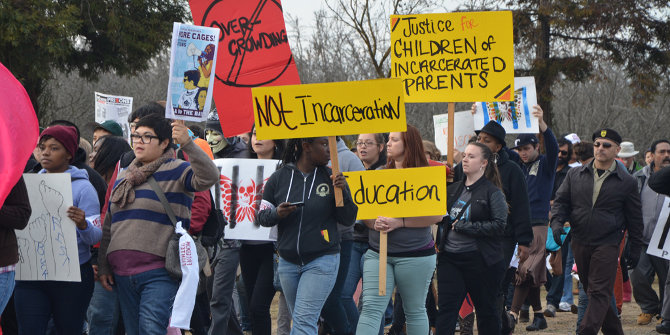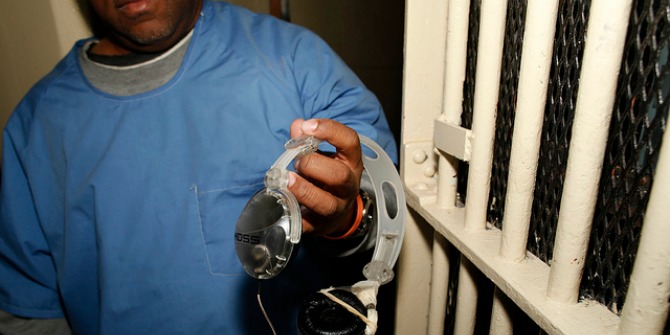
 As most Americans have a religious faith of some kind, so do most of those incarcerated in US prisons. In new research, Grant Duwe and Byron R. Johnson, look at how the religion of those who are incarcerated can affect how they respond to correctional programming. Applying a model known as risk-needs-responsivity to a survey of over 2,000 incarcerated people in Minnesota, they find that greater religiosity among those incarcerated was linked to less misconduct and reoffending, but only for those who had less social support and more positive social identities.
As most Americans have a religious faith of some kind, so do most of those incarcerated in US prisons. In new research, Grant Duwe and Byron R. Johnson, look at how the religion of those who are incarcerated can affect how they respond to correctional programming. Applying a model known as risk-needs-responsivity to a survey of over 2,000 incarcerated people in Minnesota, they find that greater religiosity among those incarcerated was linked to less misconduct and reoffending, but only for those who had less social support and more positive social identities.
Religion has long been central to the American prison experience. The advent of the prison reform movement near the turn of the nineteenth century, for example, was heavily influenced by religious faith. While America’s prison systems have changed in many ways since the early nineteenth century, the importance of religious services and activities within correctional facilities has endured.
Research has so far not examined the role of religiosity within the context of the risk-needs-responsivity (RNR) model, which is the guiding framework for the delivery of correctional programming. The risk principle holds that interventions should be targeted toward higher-risk individuals, with the most intensive programs being reserved for those with the highest risk of reoffending. The needs principle suggests that programs must address individual characteristics that are related to criminal behavior. The responsivity principle indicates that interventions must account for factors that might influence the effectiveness of programming.
Examples of specific responsivity factors, which may influence whether individuals are able to successfully complete programming that targets people’s characteristics related to criminal behavior – which are known as criminogenic needs – include motivation, anxiety, different forms of learning styles, language, transportation, gender, and culture. Because the idea of specific responsivity emphasizes that programs should match their services to an individual’s preference, as one study suggests, religious faith and spirituality should be considered as a type of specific responsivity. After all, those who identify in religious or spiritual ways have been found to experience the positive effects of the support offered by the faith community.
Measuring religiosity and the risk-needs-responsivity model
In March 2021, more than 2,000 people confined in Minnesota’s prison system completed a survey designed by Minnesota Department of Corrections (MnDOC) staff to assess their needs and responsivity. We used this dataset to examine the association between religiosity and measures of risk, needs, and responsivity. In addition to containing a scale for religiosity, the survey included measures for criminal thinking, anti-social peers, social support, employment, childhood trauma, self-identity, housing and homelessness, and family/domestic relationships.
We combined these survey data with existing assessment data for education, mental health and substance use disorders along with administrative data for prison misconduct and reoffending risk. Using this dataset, we first analyzed the relationship between religiosity and the need and responsivity measures noted above. We then looked at the effect of religiosity on two measures of risk—prison misconduct and assessed recidivism risk.
Does religiosity make reoffending less likely?
A key distinction between factors likely to cause criminal behavior and responsivity factors lies in the impact each one has on reoffending. The former will not only have a significant, direct impact on reoffending, but interventions that successfully target this need will reduce recidivism. For example, substance abuse is a criminogenic need with a significant, direct impact on recidivism, and substance use disorder treatment has been shown to reduce reoffending. Specific responsivity factors, on the other hand, will have a more modest, indirect impact on reoffending that is moderated by other factors. Whatever impact a responsivity factor may have on recidivism would be moderated by other risk and responsivity factors.
According to this framework, we hypothesized that religiosity will not have a significant, direct effect on either prison misconduct or recidivism risk because it is not considered something that is linked to offending. Yet, because it is a specific responsivity factor, we hypothesized that it would have an indirect effect on prison misconduct and recidivism risk that is moderated by other factors.

McGhiever, CC BY-SA 3.0
More religiosity can mean less misconduct and reoffending in prison – but only for some
As shown in Figure 1, our findings suggested that greater religiosity was associated with a stronger positive social identity, more perceived social support, less criminal thinking, and lower employment needs. Contrary to existing research, we found that incarcerated people reporting greater levels of religiosity were more likely to have experienced childhood trauma. Our results showed that greater religiosity was associated with less misconduct and lower recidivism risk, but only for people with pro-social identities and less perceived social support.
Figure 1- The Observed Relationship Between Religiosity and Measures of Risk, Need and Responsivity

What this means for programme outcomes
We believe our findings have four key implications for theory and practice. First, the positive associations between religiosity and how individuals see themselves and perceive how much support they have is consistent with the literature. Likewise, although this study is the first—to our knowledge—to examine the relationship between religiosity and criminal thinking, the negative association observed between the two is consistent with our hypothesis. The major religious faiths generally promote a pro-social, crime-free lifestyle. The negative association we found here likely reflects the fact that as religious faith and involvement increases, the attitudes and beliefs that comprise criminal thinking decrease.
Second, the positive association found for religiosity and childhood trauma runs counter to much of what the literature has reported. But this body of research has yet to focus on a correctional population, which is—as reflected here—much more likely to include males as well as individuals identifying as Black, Indigenous, and people of color (BIPOC) than the general population. While it is unclear why this finding does not align with much of the existing research, we suspect that it may reflect the use of religious faith to help deal with, and perhaps make sense of, a traumatic personal experience.
Third, while the results for religiosity and self-identity were consistent with expectations, those for religiosity and perceived social support were not. More specifically, religious faith and involvement generally provides people with a positive outlook, giving them a sense of purpose and meaning in their lives. As such, we would anticipate that greater levels of religiosity would be associated with reduced misconduct and recidivism risk for people transformed by their religious faith who have a stronger pro-social identity. Put another way, if religious faith and involvement did not change self-identities and people maintained a negative, anti-social view of themselves, we would not expect a reduction in misconduct or recidivism risk.
Although we would anticipate the negative association between religiosity and the two measures of risk would be more likely for those with more perceived social support, we found the opposite to be true. It may be that the beneficial effects of greater religiosity, at least for these two risk measures, are more pronounced for those who have less perceived social support: people with more social support may be more likely to have better outcomes regardless of how religious they are. For those with less perceived support, however, greater religiosity may have a greater transformative effect on behavior.
The importance of assessing religiosity
Finally, our results suggest that assessing for religiosity may yield some benefits not only for the individuals on probation or in prison but also for correctional agencies. Even though our results support the notion that religiosity is a specific responsivity factor that warrants attention, we are not aware of any commonly used risk-needs-responsivity model instruments that assess for religious faith and spirituality or, for that matter, identity, and social support.
While future research is needed to better understand the association between religiosity and correctional program participation, assessing for religiosity could help identify individuals who may have an interest in faith-based interventions. More important, our results further suggest that assessing for religiosity could, when paired with identity and social support assessments, potentially yield better risk-related outcomes. For example, compared to people scoring high on religiosity who have shed their old identities in favor of ones that are more pro-social, individuals scoring high on religiosity who still have an anti-social identity will likely need more resources, including programming, to stop from reoffending.
- This article is based on the paper ‘New Insights for “What Works”? Religiosity and the Risk-Needs-Responsivity Model’ in Crime & Delinquency.
- Please read our comments policy before commenting.
- Note: This article gives the views of the author, and not the position of USAPP – American Politics and Policy, nor the London School of Economics.
- Shortened URL for this post: https://bit.ly/3WCze2O






